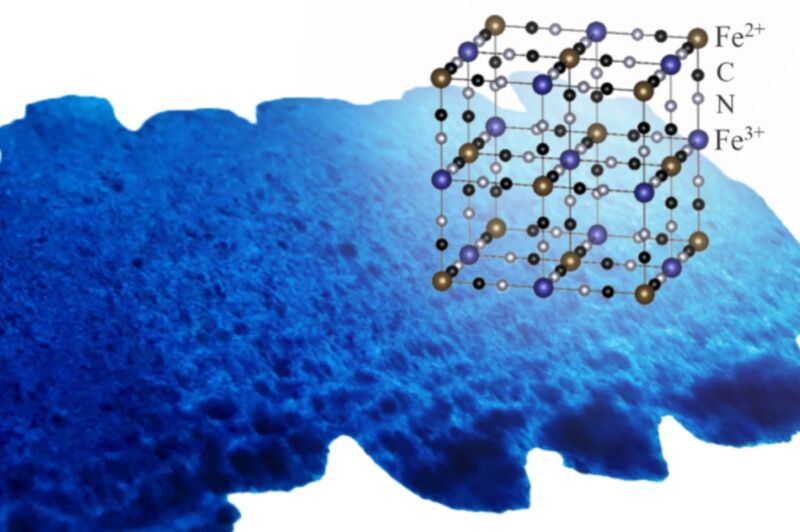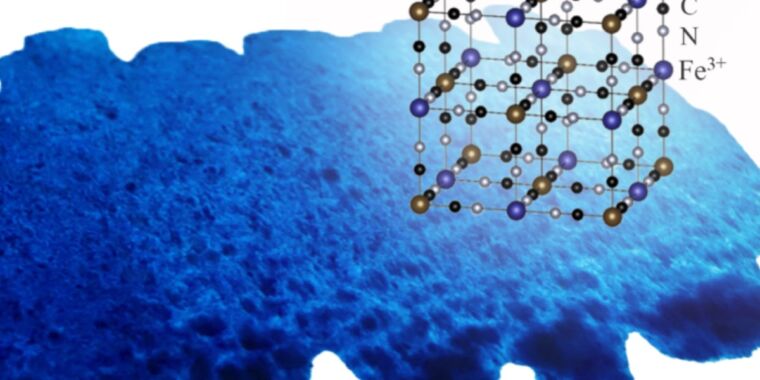
Reiko Matsushita/Shinta Watanabe
Gold and certain other precious metals are main ingredients in computer chips, including those used in consumer electronics such as smartphones. But it can be difficult to recover and recycle those metals from electronic waste. Japanese researchers have found that a pigment commonly used by artists called Prussian blue can extract gold and platinum-group metals from e-waste much more efficiently than conventional bio-based absorbents, according to a recent paper published in the journal Scientific Reports.
“The amount of gold in a ton of mobile phones is 300 to 400 grams, which is 10 to 80 times much higher than that in a ton of natural ore,” the authors wrote. “The other elements have a similar situation. As a result, recovering those precious elements from e-waste is much more effective and efficient compared to their natural ore collections.”
Prussian blue is the first modern synthetic pigment. Admittedly, there was once a pigment known as Egyptian Blue that was used in ancient Egypt for millennia; the Romans called it caeruleum. But after the Roman Empire collapsed, the pigment was not used much, and eventually the secret of how it was made was lost. (Scientists have since figured out how to mimic the process.) So before Prussian blue was discovered, painters had to use indigo dye, smalt, or the expensive ultramarine of lapis lazuli for deep blues.
It is believed that Prussian blue was first accidentally synthesized by a Berlin paint maker named Johann Jacob Diesbach around 1706. Diesbach tried to make a red pigment, mixing potassium, ferrous sulfate and dried cochineal. But the potash he used was apparently stained with blood – it is believed from a cut or similar minor injury. The ensuing reaction created a distinctive blue-tinted iron ferrocyanide and was eventually named Prussian Blue (or Berlin Blue).
The earliest known painting with Prussian blue is currently that of Pieter van den Werff Burial of Christ (1709), but the recipe was published in 1734 and Prussian blue soon became widespread among artists. Hokusai’s famous artwork, The Great Wave off Kanagawais one of the most famous works to use the pigment, along with that of Vincent van Gogh The Starry Night and many of Pablo Picasso’s ‘Blue Period’ paintings.
The pigment has other uses. It is often used to treat heavy metal poisoning from thallium or radioactive cesium, because its grid-like network structure — similar to a jungle gym — can trap metal ions from those metals and prevent them from being absorbed by the body. Prussian blue helped remove cesium from the soil around the Fukushima nuclear power plant after the 2011 tsunami. Prussian blue nanoparticles are used in some cosmetics and are used by pathologists as a stain to detect iron in, for example, bone marrow biopsy samples.
So it is a very useful substance, which is why the Japanese authors of this last paper decided to explore other possible practical applications. They analyzed how Prussian blue takes up multivalent metals, such as platinum, ruthenium, rhodium, molybdenum, osmium and palladium, using X-ray and ultraviolet spectroscopy. They were amazed at how well the pigment retained its jungle gym structure while replacing iron ions in the framework — the secret to its impressive absorption efficiency compared to bio-based absorbents. That’s good news for e-waste recycling.
Prussian blue could also solve one of the challenges of nuclear waste disposal, according to the authors. Current practice involves converting radioactive liquid waste to a glassy state in a reprocessing plant prior to disposal. But platinum group metals can build up on the walls of the smelters, eventually causing uneven heat distribution. Thus, the melters must be flushed after each use, which in turn increases costs. Prussian blue could remove those deposits without having to flush the melters after each use.
DOI: Scientific Reports, 2022. 10.1038/s41598-022-08838-1 (About DOIs).

